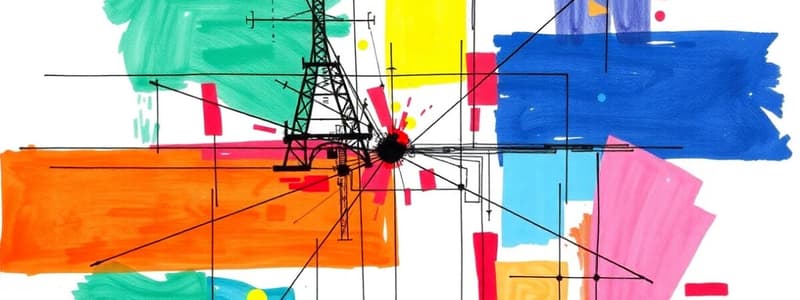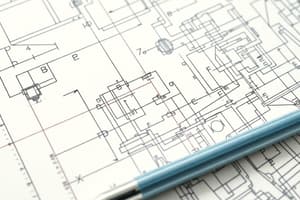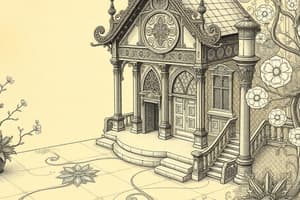Podcast
Questions and Answers
Which type of view shows only features that need clarification?
Which type of view shows only features that need clarification?
- Local view (correct)
- Aligned view
- Principal view
- Half view
A half view includes the entire object without any breaks.
A half view includes the entire object without any breaks.
False (B)
What is the purpose of using a principal view?
What is the purpose of using a principal view?
To better describe an object and facilitate dimensioning.
An __________________ is created by rotating the object's features about a symmetry axis.
An __________________ is created by rotating the object's features about a symmetry axis.
Match the following views with their descriptions:
Match the following views with their descriptions:
What should be avoided when representing a half view?
What should be avoided when representing a half view?
A center line in half view acts as a line of symmetry.
A center line in half view acts as a line of symmetry.
Why is it advisable to show symmetric features in true size at true distances?
Why is it advisable to show symmetric features in true size at true distances?
What is the primary purpose of using conventions in orthographic writing?
What is the primary purpose of using conventions in orthographic writing?
Incompleted views include features that can be clearly seen from a specific viewing direction.
Incompleted views include features that can be clearly seen from a specific viewing direction.
Name two types of convention practices mentioned.
Name two types of convention practices mentioned.
The ______ view refers to a side view that has omitted features not visible from the chosen perspective.
The ______ view refers to a side view that has omitted features not visible from the chosen perspective.
Match the following types of convention practices with their definitions:
Match the following types of convention practices with their definitions:
Which of the following is NOT a type of convention practice?
Which of the following is NOT a type of convention practice?
Using a dash line to represent a hidden edge is an example of convention practice.
Using a dash line to represent a hidden edge is an example of convention practice.
What advantage does placing the side view beside the top view provide?
What advantage does placing the side view beside the top view provide?
What is the purpose of an enlarged view in technical drawings?
What is the purpose of an enlarged view in technical drawings?
The non-existing line of intersection is visible in object drawings with rounds and fillets.
The non-existing line of intersection is visible in object drawings with rounds and fillets.
What must be specified for an enlarged view?
What must be specified for an enlarged view?
A __________ view is drawn at a larger scale and focuses on a selected portion of the full view.
A __________ view is drawn at a larger scale and focuses on a selected portion of the full view.
Match the following terms with their definitions:
Match the following terms with their definitions:
When would you show additional lines projected from actual intersections?
When would you show additional lines projected from actual intersections?
Aligned convention applies solely to the representation of ribs.
Aligned convention applies solely to the representation of ribs.
What impression does the aligned convention give when applied to views of holes?
What impression does the aligned convention give when applied to views of holes?
Flashcards
Partial View
Partial View
A view showing only essential portions of an object to clarify specific features.
Half View
Half View
A partial view showing half of the object, often using a center line as a line of symmetry.
Local View
Local View
A view focusing on a specific feature or detail of the object, often to provide a clearer representation.
Aligned View
Aligned View
Signup and view all the flashcards
Why use Aligned View?
Why use Aligned View?
Signup and view all the flashcards
Convention Practice
Convention Practice
Signup and view all the flashcards
Symmetry Symbol
Symmetry Symbol
Signup and view all the flashcards
Break Line
Break Line
Signup and view all the flashcards
Enlarged view
Enlarged view
Signup and view all the flashcards
Non-existing line of intersection
Non-existing line of intersection
Signup and view all the flashcards
Orthographic Projection
Orthographic Projection
Signup and view all the flashcards
Apply convention
Apply convention
Signup and view all the flashcards
Align view of holes
Align view of holes
Signup and view all the flashcards
Align view of ribs
Align view of ribs
Signup and view all the flashcards
Align view of ribs & holes
Align view of ribs & holes
Signup and view all the flashcards
Align view of ribs & holes & keyway
Align view of ribs & holes & keyway
Signup and view all the flashcards
Orthographic Convention
Orthographic Convention
Signup and view all the flashcards
Purpose of Conventions
Purpose of Conventions
Signup and view all the flashcards
Alternate Side View Convention
Alternate Side View Convention
Signup and view all the flashcards
What is an Incompleted View?
What is an Incompleted View?
Signup and view all the flashcards
Aligned View Convention
Aligned View Convention
Signup and view all the flashcards
Enlarged View Convention
Enlarged View Convention
Signup and view all the flashcards
Non-Existing Intersection Line
Non-Existing Intersection Line
Signup and view all the flashcards
Cylinder Intersection
Cylinder Intersection
Signup and view all the flashcards
Study Notes
Chapter 5: Convention Practice in Orthographic Writing
- Orthographic writing conventions are commonly accepted practices that sometimes disregard strict rules of orthographic projection.
- These conventions improve drawing clarity, ease dimensioning, reduce drafting effort, and save or efficiently use drawing space.
Topics
-
Definition
- Conventions are commonly accepted practices that sometimes ignore certain orthographic projection rules, with the aim of creating more readable and practical technical drawings.
-
Purposes
- Improve drawing clarity.
- Facilitate dimensioning.
- Reduce drafting effort.
- Save or efficiently use drawing space.
-
Types of Conventions
-
Alternate position of side view
- Used when an object's height is smaller compared to its depth, placing the side view next to the top view to save space and enhance clarity.
-
Incomplete view
- Eliminates features not clearly visible from a chosen viewpoint, simplifying the representation.
- Includes sub-types such as incomplete side view, partial view, half view and local view.
-
Aligned view
- Features are rotated in a principle view and shown aligned along a symmetry axis or centre line.
- Used to make drawing of symmetrical features more efficient.
-
Enlarged view
- A selective view from a full view drawing with a larger scale.
- In full view, the selected portion has a label and a border using continuous thin lining.
- Enlarged view requires the specified name and scale.
-
Non-existing intersection line
- Avoids potentially confusing representations of intersections occurring due to fillets and rounds, by showing projected lines as if fillets or rounding were not present.
-
Cylinder intersection
- Illustrates how conventions are used to represent intersections involving cylinders.
-
Examples
- An example shows using a dash line to represent hidden edges.
- Examples of alternate positioning of views are given to illustrate how the top and side views are oriented.
- Examples show incomplete views
- Examples of partial views, half views and local views are showcased.
- Examples illustrate the application of aligned views of holes and ribs.
- Enlarging and showing the application of enlarged views.
- Examples demonstrate how non-existing intersection lines are used when fillets and rounds are present.
- Examples of intersections between a fillet and a round are shown.
- Examples of intersections between a round and a plane surface are presented.
- Examples illustrate the difference in drawing a large hole versus a small hole in a cylinder.
Studying That Suits You
Use AI to generate personalized quizzes and flashcards to suit your learning preferences.




